artguide.com; via a Russian Facebook friend
Мария Силина об ошибках «Романтического реализма».
[JB note: For years a Russian partner and I tried to organize a exhibit comparing Norman Rockwell and Socialist Realism. But the project regrettably didn't financially work out, despite the support it obtained from persons interested in American-Russian cultural relations. See (1) (2) (3)]
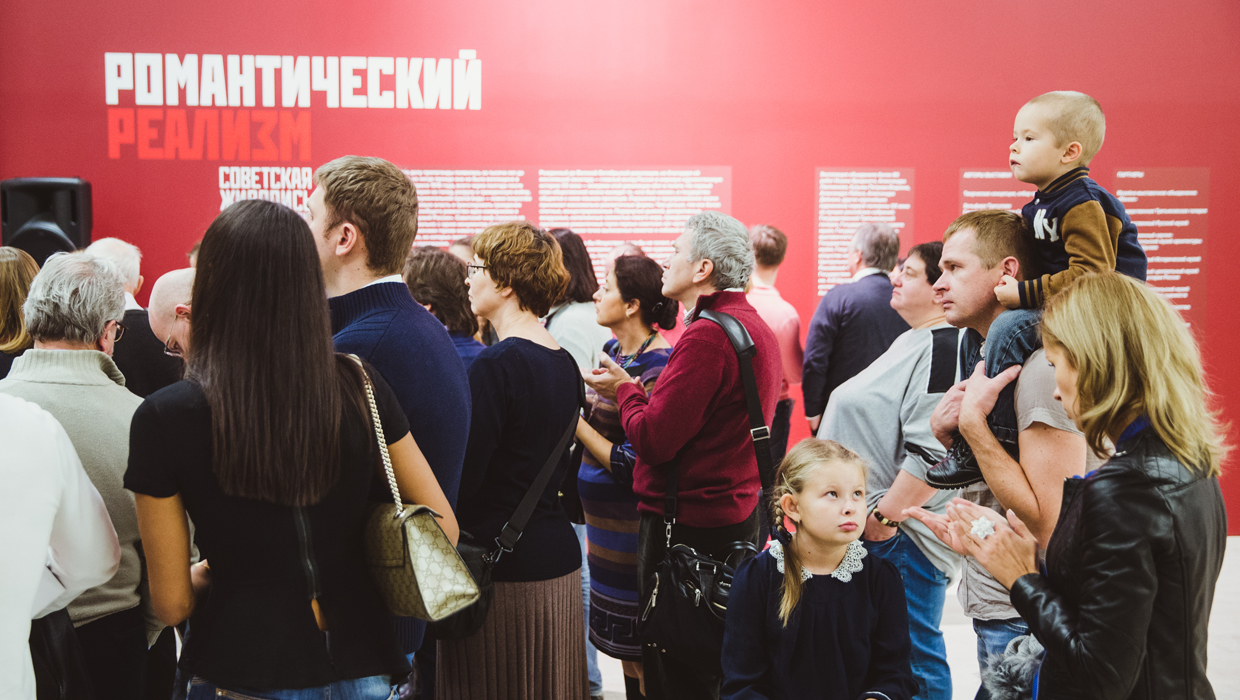
В ноябре–декабре 2015 года в Центральном выставочном зале «Манеж» в Москве прошла выставка «Романтический реализм. Советская живопись 1925–1945 годов» — еще одна попытка собрать наиболее интересные работы заявленного периода. Авторы выставки — директор ГТГ Зельфира Трегулова, главный художник «Первого канала» и архитектор Дмитрий Ликин, продюсер и режиссер Эдуард Бояков — поставили одной из своих целей разрушение «клише об отсутствии художественных достоинств у этих полотен». Однако уже в самом названии выставки — один из главных мифов о советском искусстве, который так и не был развенчан в экспозиции, — миф о существовании советского искусства как единого целого. С 1925 по 1945-й в Советском Союзе прошло несколько кампаний по привлечению художников к нуждам государственной пропаганды, сменилось множество периодов совершенно разного художественного, стилистического и административного содержания. Более того, во время каждой из подобных кампаний предшествующее поколение мастеров начинало подвергаться гонениям как идеологически чуждое — но на выставке это никак не показано, все ее участники объединены в общий стройный хор.

Такой «неразличающий» подход как нельзя лучше демонстрирует крайне востребованное сегодня стремление к нормализации истории.Министр культуры РФ Владимир Мединский на своей открытой лекции «Мифы о революции и гражданской войне» в МГИМО в ноябре 2015 года заявил, что в гражданской войне участвовали только две силы — «белые» и «красные», но победила, по словам министра, в итоге третья сила — «историческая Россия», и в ней нет ни героев, ни антигероев[1]. Авторы «Романтического реализма» упростили в истории советской живописи то, что еще не обрело сегодня сложность и полноту профессионального осмысления. В каталоге выставки можно обнаружить буквальное обращение к советской риторике времен холодной войны: искусство авангарда было побеждено понятным зрителю искусством реализма, который как нельзя лучше подходил на роль пропагандистского искусства[2].Впрочем, эта теоретическая рамка осталась на уровне декларации; из тематических разделов, на которые была поделена выставка, и текстов каталога следует, что авангард и реализм объединили усилия, чтобы в СССР победила та самая историческая Россия, состоящая из набора «очевидных, но дорогих нашим сердцам истин» — воспетого труда, мечтаний о небе, семейного счастья и героической победы в Великой отечественной войне[3]. Подобная позиция, в основе которой лежит обращение к «вечным ценностям», позволят авторам игнорировать и замалчивать многие аспекты истории советского искусства: феномен пролетарского искусства в 1928–1932 годы, с его оригинальной трактовкой наглядной агитации; репрессии в художественных кругах в 1936–1939 годах, приведшие к самоцензуре многих авторов; создание сталинской индустрии искусства 1936–1953 годов, в которой массовое производство станковой живописи парадоксальным образом подкреплялось разговорами об особом вдохновении художника, результатом которое является появление шедевров. Под знаменем некоего единого «романтического реализма» авторы выставки попытались представить плохо объединяемые драматичные перипетии истории советского искусства как единый дискурс о художественно интересных вещах. В настоящей статье я хотела бы разрушить иллюзию единства необъединяемого, рассмотрев некоторые из многочисленных эпизодов смены идеологических директив и последующих за ними репрессий.
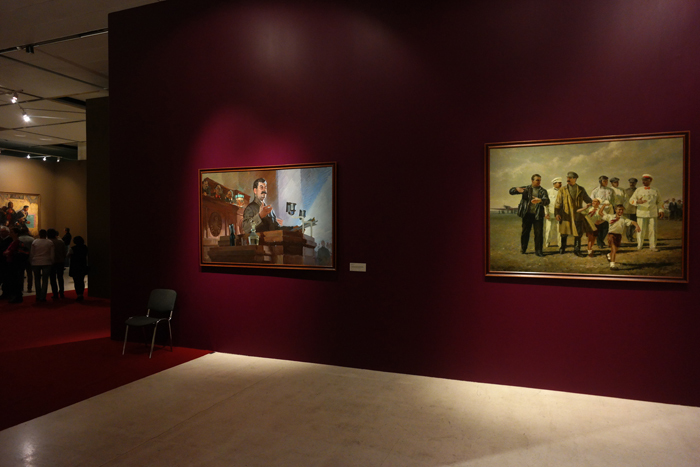
Почти все работы, показанные на «Романтическом соцреализме» хрестоматийны; многие из них начали попадать в сборники советского искусства еще с конца 1930-х годов. Работы Исаака Бродского, Александра Дейнеки и Кузьмы Петрова-Водкина самые «чистокровные» по родословной, они как были признаны в середине 1930-х эталонными образцами соцреалистической живописи, так и кочевали из книги в книгу[4]. Бо́льшая часть этих полотен находится в постоянных экспозициях центральных музеев — Государственной Третьяковской галерее в Москве (ГТГ) и Государственном Русском музее в Санкт-Петербурге (ГРМ), и в пересмотре художественной ценности не нуждается, зато их присутствие на выставке придают ей вес. Другая часть работ, показанных в Манеже (в основном, это картины, написанные в 1928–1937 годах), находится в коллекции Государственного музейно-выставочного центра РОСИЗО. Эти произведения активно вводились в художественный оборот с 2000-х годов и принимали участие в таких выставках, как «Коммунизм — фабрика мечты» (кураторы Борис Гройс и Зельфира Трегулова, Франкфурт-на-Майне, 2003–2004), «Борьба за знамя» (куратор Екатерина Деготь, Москва, 2008), «Соцреализм. Инвентаризация архива» (куратор Зельфира Трегулова, Москва, 2009–2010). В то время когда РОСИЗО руководила Зельфира Трегулова, были подготовлены выставки соцреализма в Москве, Орле, Самаре, где также экспонировались указанные работы. Эти произведения охватывают два важных периода — формирование пролетарской культуры 1928–1932 годов и репрессий 1936–1937 годов.

Соцзаказ в области станковой живописи был введен на государственном уровне в 1928 году в период культурной революции 1928–1932-м. На первый план вышла новая, антиклассическая модель работы художников — теперь они были погружены будни пролетариата и откликались на актуальные события международной и советской политики. В дискуссиях и на страницах журналов провозглашался разрыв с буржуазной эстетикой, отказ от элитарности, искусство было призвано включиться в общественную жизнь. С 1928 года московский и ленинградский ВХУТЕИНы стали выпускать художников-пропагандистов. Именно молодых выпускников вузов, учеников Ильи Машкова, Роберта Фалька, Давида Штеренберга, привлекали к работе над созданием пролетарской культуры. В этот период получили заказы Екатерина Зернова, Василий Купцов, Константин Вялов, представленные на выставке в Манеже. Их командируют на стройки первой пятилетки (1928–1932), на производство и строящиеся заводы. Классические формы монументального и станкового искусства получают неклассические трактовки: живопись и скульптура становятся новыми видами агитационного искусства, выполненными в разнообразных модернистких стилях. Так, рождается пролетарская живопись, выполненная в традициях французского постимпрессионизма, немецкого экспрессионизма, новой вещественности, неоархаики, использующая супрематические и конструктивистские приемы в живописи фигуративного модернизма. Фактически началось формирование политически ангажированной, но художественно независимой среды. Историю взаимоотношений художественных групп, которые (безуспешно) боролись за право говорить от лица партии, еще предстоит пересмотреть. Это искусство, питавшееся из большого числа теоретических и стилистических источников, не нашло места ни в истории искусства второй половины 1930–1950-х годов, ни в появившейся к 1980-м годам концепции «авангардное — тоталитарное»[5]. Низкое качество и сиюминутная политическая направленность многих работ и сейчас ошибочно воспринимаются как продукт сталинской эпохи 1936–1953 годов, но на выставке в Манеже тематический принцип полностью устранил какую-либо проблемность и оригинальность этого периода.
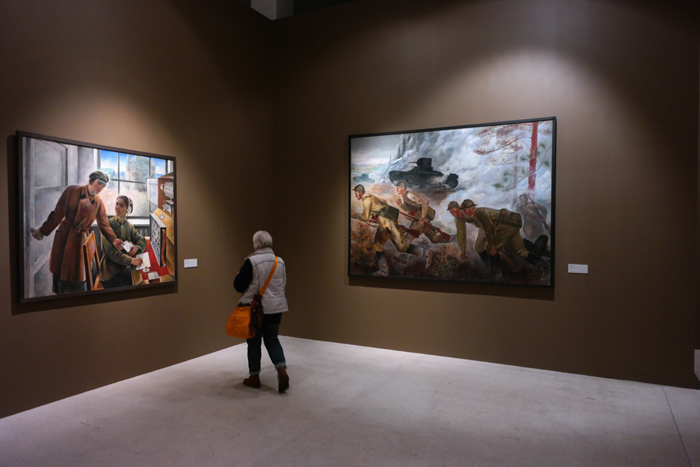
В 1932–1935 году происходило постепенное формирование новой институциональной и идеологической структуры творческой жизни, начавшееся с объединения всех художественных организаций в 1932-м. Тогда же стали применять термин «социалистический реализм»[6]. Пролетарское искусство 1928–1932 годов и его теоретические обоснования, антиклассическая, марксистская эстетика канули в небытие. В 1933 году Осип Бескин, ответственный редактор двух центральных журналов по искусству — «Искусство» и «Творчество», — инициировал травлю художников-формалистов Давида Штеренберга, Александра Тышлера и Александра Лабаса[7]. Хотя работы этих авторов представлены на «Романтическом реализме», описанный выше сюжет авторами проекта был также опущен как несущественный для истории художественного качества советской живописи 1925–1945 годов.
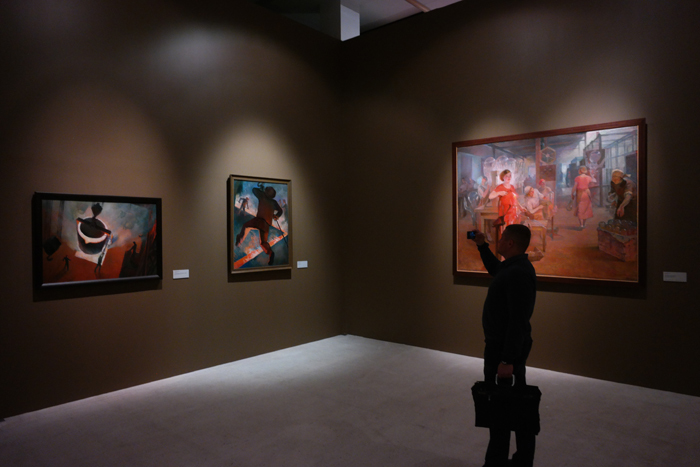
После убийства Сергея Кирова в 1934 году близость политических репрессий заставила художников действовать в условиях самоцензуры.Юрий Пименов, бывший в начале 1930-х последователем немецкого экспрессионизма, с середины 1930-х резко поменял направление своей художественной практики и тем вписал себя в пантеон соцреалической живописи, но очевидно, что его профессиональное мастерство никуда не делось, так же как и профессионализм других ведущих тогда соцреалистов — Александра Самохвалова и Самуила Адливанкина. Сумевшие интегрироваться, выжить, не сломаться в новой сталинской системе, художники могли продолжать работать и давать художественно интересные картины. Но вопрос того, какой ценой доставалась им возможность работать, не теряет своей остроты, так же как и разговор о профессионализме художников из экспозиций ГТГ и ГРМ без упоминания условий их работы.
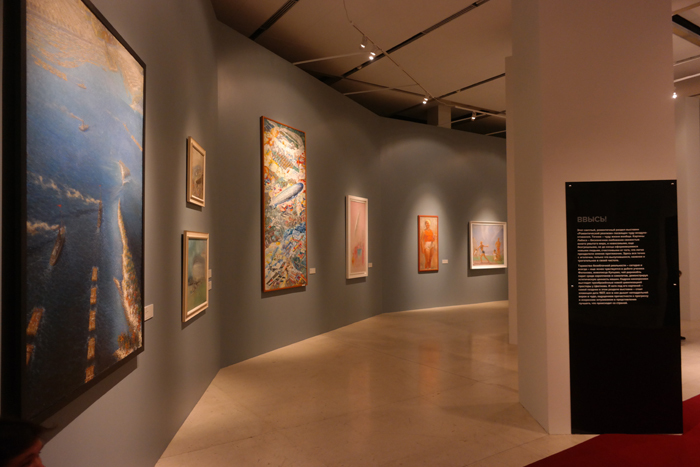
С января 1936 года начала формироваться кампания против формализма и натурализма.В партийной газете «Правда» нападают на формалистов и натуралистов: ряды первых ширятся, ряды вторых заполняются бывшими АХРовцами. Платон Керженцев, глава Комитета по делам искусств, определят список работ, предназначенных для демонтажа из экспозиций музеев. Кроме работ радикальных Казамира Малевича и Владимира Татлина, снимаются вещи экспонируемого в Манеже ОСТовца Алекасандра Лабаса и хрестоматийного соцреалиста Павла Соколова-Скали[8]. В 1938 году членов Московского союза художников перерегистрировали, исключая или переводя в кандидаты тех, кто не «изжил» формализм и натурализм в творчестве. Судьба художников культурной революции сложилась по-разному: критикуемый формалист Лабас с конца 1930-х работал над живописными агитационными панно на Всесоюзной сельскохозяйственной выставке 1939 года. Василий Купцов, один из учеников Павла Филонова, не выдержав психологического давления на учителя и его школу, повесился в 1935-м. Впрочем, в каталоге об этом тоже ни слова.
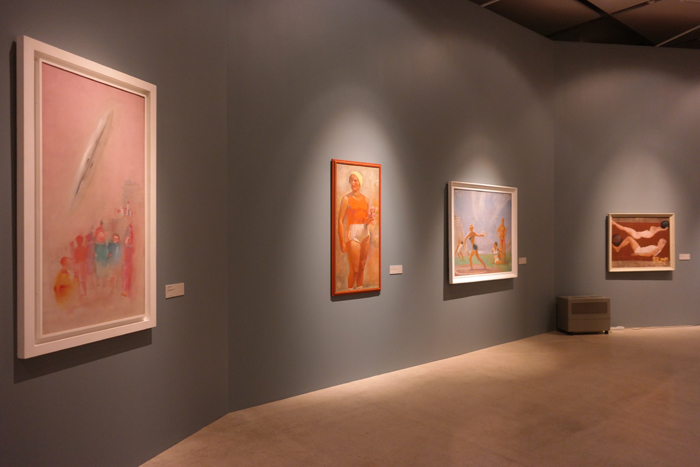
Шоковый эффект от процессов в области искусства был закреплен начавшимися политическими репрессиями. С августа 1936 года начинаются показательные суды над оппозиционерами, так называемые Московские процессы (1936–1938), которые вылились в массовые политические преследования. Аресты, самоубийства и расстрелы по политической линии шли параллельно административным репрессиям и травле художников на бесконечных собраниях. Работать в таких условиях было невозможно[9].
Протеже Иосифа Уншлихта (расстрелян в 1938-м) и Льва Троцкого (убит в 1940-м) Евгений Кацман отмечал в дневнике 1937 года: «Любопытно, что все аресты идут по линии троцкистов и белогвардецев, а вовсе не по линии натурализма и формализма», — и далее перечислял: «Михайлов — негодяй, но реалист, Шухаев — негодяй, но реалист, Фаворский — негодяй, но формалист, Эфрос — негодяй, но формалист, Бигас — формалист, троцкист, Киршон — якшается с троцкистами, но реалист — натуралист, Славинский — сволочь, формалист»[10].

В действительности, не стиль, не направление и не художественное качество работ делало из художников жертв. После 1936–1939 годов из истории советского искусства были выброшены огромное количество имен и произведений, многие художники пострадали из-за близости к политикам, попавшим в немилость. С конца 1930-х история советской живописи писалась как история прямого пути к реализму. В 1960-е, после процесса десталинизации, вся траектория развития советской культуры получила название ленинской, и она тоже закрепила незыблемость и приоритет реалистического метода в СССР. Однако в 1937–1939 годы репрессированы были и художники реалисты, и натуралисты[11]. Латышский стрелок Вольдемар Андерсон, художник-реалист, был репрессирован, также как и формалист Александр Древнин; художник реалист Николай Михайлов был сослан за блик на картине и т. д.[12]. Ахровцы Яков Цирельсон и Федор Коннов погибли и расстреляны за причастность к московской группе художников террористов в 1938[13]. Быть уверенным в своем будущем в то время не мог никто.

На эти годы приходится расцвет искусства соцреализма, созданного не просто по политическому заказу, как это было в 1928–1932 годы, но под страхом смерти. Критика, звучавшая на художественных дебатах, проходивших в эпоху культурной революции, становится небезопасной, и руководство ими переходит в руки лояльным государству служащим. Именно в этот период формируется то советское искусство, которое у поколений 1960–1980-х стало ассоциироваться с масштабной массовой политической индустрией соцреализма: оно обрело свой стиль (все тот же соцреализм), художественную организацию (Союз художников), места обитания (государственные выставки) и политические (Комитет по делам искусств, Министерство культуры) и административно-хозяйственные органы (Художественный фонд)[14].
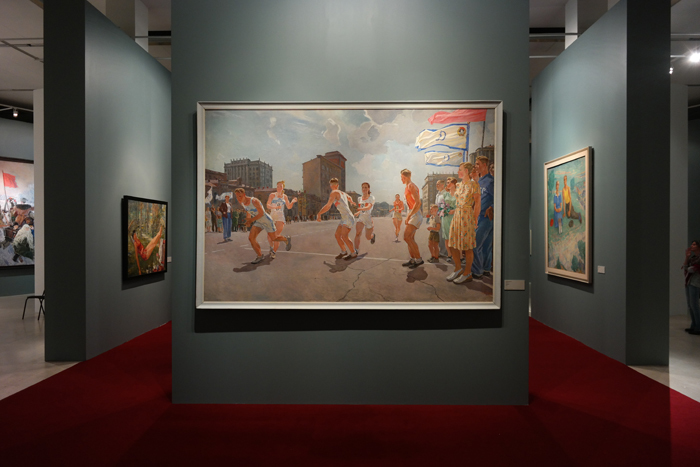
Особую значимость в это период приобрели государственные художественные выставки, возникшие в сталинской системе производства живописи, успешно продержавшейся до 1980-х годов. Во второй половине 1930-х открываются выставки «Индустрия социализма» (1936–1939), «ХХ лет РККА и Военно-морского флота» (1938), ВСХВ (1935–1939), и критики провозглашают рождение соцреалистического искусства и изживание в советском обществе заблуждений формалистов и натуралистов[15]. С 1947 года государственные выставки стали ежегодными. Несмотря на разность тем, все они имели общие черты, которые легли в основу всей художественной экономики СССР. Среди них стоит отметить почти конвейерное производство художественных работ на определенные темы, на выполнение которых отводилось в лучшем случае несколько месяцев. Именно на эти выставки принимались сотни работ, большая часть из них впоследствии стала ассоциироваться с неискренней, халтурной и бесталанной работой. Это представление — «отсутствие художественных достоинств» — как раз и транслируют авторы манежной выставки, распространяя его на все довоенное искусство СССР. Однако вопросы халтуры и неискренности требуют особого внимания.
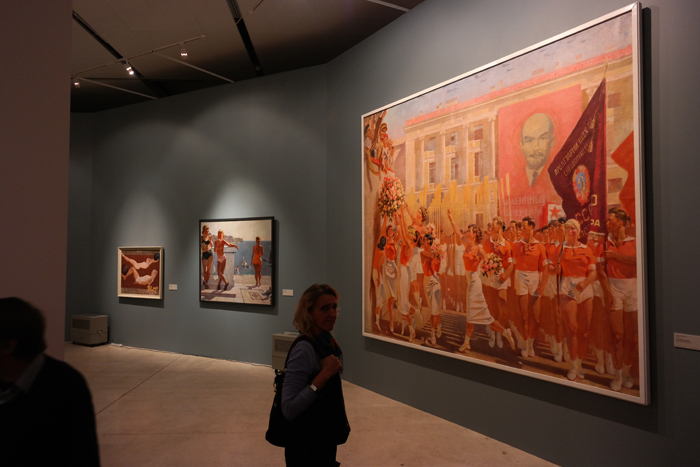
Искусствоведы также были скованы культурными и художественными реалиями сталинского времени, что не могло не отразиться на терминологии. С конца 1930-х в текстах и разговорах об искусстве начинает проявляться «неоклассический» подход к анализу произведений: вместо пролетарского реализма, демонстрации изменения психологии масс и отображения классовой диалектики в композициях картин речь начинает идти об идеалах вдохновленного творчества, правдивом и простом искусстве. Профессиональные журналы вместо дискуссионных статьей о современной художественной практике заполняются публикациями о русском реализме XIX века. Вместо репортажей о художниках на производстве или новых агиткампаниях цитируются Никола Буало и Дени Дидро, теоретики эпохи классицизма и Просвещения XVIII века[16]. Эти неоклассические установки входили в несомненное противоречие с укреплением и еще большим расширением индустрии социалистического искусства. В статьях, на собраниях, в университетах учили неоклассическому представлению о шедеврах, о гениальности отдельного творца, в то время как художники работали бригадами по двадцать человек и получали ежемесячную оплату по прейскурантам за квадратные метры. В послевоенные годы опыт производства социалистической массовой живописной продукции был перенесен и на присоединенные территории Западной Белоруссии, Западной Украины и Латвии[17].

В 1960-е годы (то есть после процесса десталинизации) неоклассические представления о вдохновленном творчестве и сопутствующем ему появлению шедевров закрепилось как в официальной, так и противостоящей официозу традиции. Советские партийные и культурные деятели сформулировали так называемый ленинизм в культуре, который подразумевал не только «понятие партийности и народности искусства, но и высокоталантливое художественное мастерство»[18]. То есть как раз настаивали на том, что политическое искусство должно быть художественным и должно создаваться вдохновением и талантом — и это именно то, о чем сегодня пишут авторы выставки в Манеже. В альтернативном партийным лозунгам дискурсе соцреализм стал ассоциироваться с халтурой, которому, соответственно, противопоставлялось искреннее, вдохновленное и настоящее искусство. Поэтому, вопреки заявлениям о пересмотре истории советской живописи, о которой авторы выставки в Манеже заявляли в сопроводительном тексте и в интервью СМИ, никакого радикального жеста не делается, они лишь продолжают эту линию рассмотрения искусства с точки зрения противопоставления «халтуры» и «вдохновения».
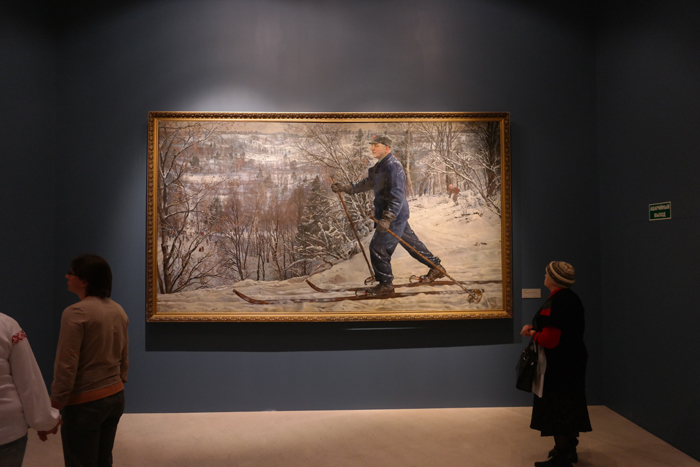
Однако проблема сегодняшнего понимания советского искусства не в том, что в советской живописи нельзя найти художественности и таланта или, по крайней мере, профессионализма. Существует история агитационной живописи 1928–1932 годов, которая требует ее изучения как с точки зрения организационных форм работы, так и ее включенности в интернациональную историю модернисткого и социально-ориентированного искусства. Также необходим анализ сталинской живописи 1930–1950-х, которая создавалась художниками, свидетелями репрессий, в условиях двойного диктата — пропаганды шедевров и реалий конвейерного производства агитационных картин. Именно эта двойственность задавала рамки не только самого общего понятия «советской живописи», но также истории преемственности поколений довоенного и послевоенного времени, складывания неофициального и антисоветского дискурса с 1960-х годов, явлений нонконформизма и соц-арта, которые переосмысляли опыт работы советских художников.
ПРИМЕЧАНИЯ
- ^ Мединский В. В противоборстве красных» и «белых» победила третья сила — историческая Россия [Электронный ресурс] // Официальный сайт Министерства культуры Российской Федерации / Владимир Мединский. — Режим доступа: http://mkrf.ru/press-center/news/ministerstvo/vladimir-medinskiy-v-protivoborstve-krasnykh-i-belykh-pobedila-tretya-sila-istor (дата обращения: 08.12.2015).
- ^ Романтический реализм. Советская живопись 1925–1945. Каталог выставки // автор текстов: Юлия Тарнавская. — М., 2015.
- ^ Романтический реализм. Советская живопись 1925–1945. Каталог выставки //автор текстов: Юлия Тарнавская. — М., 2015.
- ^ Меликадзе Е., Сысоев П. Советская живопись // Е. Меликадзе, П. Сысоев. — М.: Искусство, 1939.
- ^ Деготь Е. Эстетическая революция культурной революции / Екатерина Деготь // Борьба за знамя. Советское искусство между Троцким и Сталиным 1926–1936. — М.: PW-Autograph, 2009. — С. 44–53.
- ^ Избавление от миражей: соцреализм сегодня: Сб. ст. // сост. Е. Добренко. — М.: Советский писатель, 1990. — С. 119–123.
- ^ Бескин О. Формализм в живописи // Осип Бескин. — М.: ВСЕКОХудожник, 1933.
- ^ Максименко Л. Сумбур вместо музыки: сталинская культурная революция, 1936–1938 // Л. Максименко. — М.: Юридическая книга, 1997. — С. 229.
- ^ Ройтенберг О. Неужели кто-то вспомнил, что мы были... // Ольга Ройтенберг. — М.: Галарт, 2008.
- ^ Хвостенко Т. Вечера на Масловке близ Динамо: в 2 т. // Татьяна Хвостенко. — М.: , 2003. — Т. 2: За фасадом пролетарского искусства. — С. 9.
- ^ Репрессированные художники, искусствоведы [Электронный ресурс] // Сахаровский центр :: Москва :: cайт Сахаровского центра / [сост. Валентина Тиханова]. — Режим доступа:http://www.sakharov-center.ru/asfcd/khudozhniki (дата обращения: 08.12.2015).
- ^ Галина Загянская Г. Стенограмма экстренного заседания правления МОССХ [Электронный ресурс] // ЖУРНАЛ КОНТИНЕНТ / Галина Загянская. — Режим доступа: http://e-continent.de/publication/Archive/2011y/148n/40s/ (дата обращения: 08.12.2015).
- ^ Цирельсон Яков Исаакович. Живописец [Электронный ресурс] // Сахаровский центр :: Москва :: cайт Сахаровского центра / [сост. Валентина Тиханова]. — Режим доступа: http://www.sakharov-center.ru/asfcd/khudozhniki/?t=page&id=221 (дата обращения: 08.12.2015); Коннов Фёдор Данилович. Живописец, график [Электронный ресурс] // Сахаровский центр :: Москва :: cайт Сахаровского центра / [сост. Валентина Тиханова]. — Режим доступа: http://www.sakharov-center.ru/asfcd/khudozhniki/?t=page&id=78 (дата обращения: 08.12.2015).
- ^ Янковская Г. А. Искусство, деньги и политика: художник в годы позднего сталинизма // Г. А. Янковская. — Пермь: Издательство Пермского государственного университета, 2007.
- ^ Щекотов Н. Живопись. // Искусство / Н. Щекотов. — 1939. — №4. — С. 59-84; Меликадзе Е., Сысоев П. Советская живопись // Е. Меликадзе, П. Сысоев. — М.: Искусство, 1939. — C. 4; Всесоюзная художественная выставка «Индустрия социализма». Каталог выставки // Государственная Третьяковская галерея. — М.Л.: Искусство, 1939. — С. 8.
- ^ Бескин О. О картине, натурализме и реализме // Искусство / Осип Бескин. — 1939. — №4. — С. 5–21; Бескин О. На пути к советской классике // Искусство / Осип Бескин. — 1951. — №5. — С. 3–6.
- ^ Московский союз советских художников. Стенограмма Всесоюзного совещания скульпторов. 27 ноября 1940 // РГАЛИ. — Ф. 2943. — Оп. 1. — Ед. хр. 2095. — Л. 28; Kruk S. Profit rather than politics: the production of Lenin monuments in Soviet Latvia // Social Semiotics / Sergey Kruk. — 2010. — №06 (20). — P. 247–276.
- ^ Павлюченков А. С. Партия, революция, искусство (1917–1927) // А. С. Павлюченков. — М.: Мысль, 1985. — C. 93.












 18 Comments
18 Comments



































